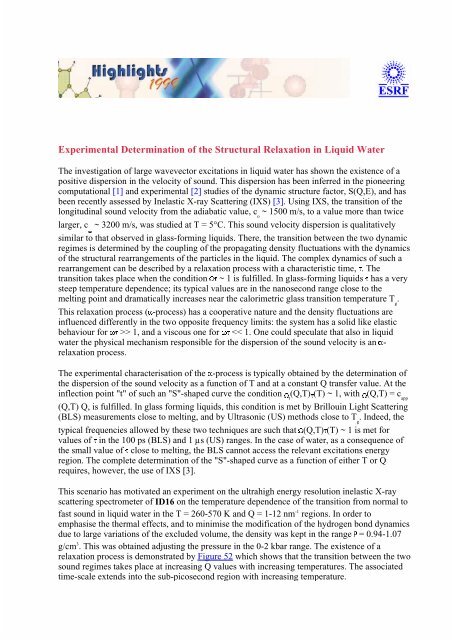Experimental Determination of the Structural Relaxation in Liquid ...
Experimental Determination of the Structural Relaxation in Liquid ...
Experimental Determination of the Structural Relaxation in Liquid ...
You also want an ePaper? Increase the reach of your titles
YUMPU automatically turns print PDFs into web optimized ePapers that Google loves.
<strong>Experimental</strong> <strong>Determ<strong>in</strong>ation</strong> <strong>of</strong> <strong>the</strong> <strong>Structural</strong> <strong>Relaxation</strong> <strong>in</strong> <strong>Liquid</strong> WaterThe <strong>in</strong>vestigation <strong>of</strong> large wavevector excitations <strong>in</strong> liquid water has shown <strong>the</strong> existence <strong>of</strong> apositive dispersion <strong>in</strong> <strong>the</strong> velocity <strong>of</strong> sound. This dispersion has been <strong>in</strong>ferred <strong>in</strong> <strong>the</strong> pioneer<strong>in</strong>gcomputational [1] and experimental [2] studies <strong>of</strong> <strong>the</strong> dynamic structure factor, S(Q,E), and hasbeen recently assessed by Inelastic X-ray Scatter<strong>in</strong>g (IXS) [3]. Us<strong>in</strong>g IXS, <strong>the</strong> transition <strong>of</strong> <strong>the</strong>longitud<strong>in</strong>al sound velocity from <strong>the</strong> adiabatic value, c o~ 1500 m/s, to a value more than twicelarger, c ~ 3200 m/s, was studied at T = 5°C. This sound velocity dispersion is qualitativelysimilar to that observed <strong>in</strong> glass-form<strong>in</strong>g liquids. There, <strong>the</strong> transition between <strong>the</strong> two dynamicregimes is determ<strong>in</strong>ed by <strong>the</strong> coupl<strong>in</strong>g <strong>of</strong> <strong>the</strong> propagat<strong>in</strong>g density fluctuations with <strong>the</strong> dynamics<strong>of</strong> <strong>the</strong> structural rearrangements <strong>of</strong> <strong>the</strong> particles <strong>in</strong> <strong>the</strong> liquid. The complex dynamics <strong>of</strong> such arearrangement can be described by a relaxation process with a characteristic time, . Thetransition takes place when <strong>the</strong> condition ~ 1 is fulfilled. In glass-form<strong>in</strong>g liquids has a verysteep temperature dependence; its typical values are <strong>in</strong> <strong>the</strong> nanosecond range close to <strong>the</strong>melt<strong>in</strong>g po<strong>in</strong>t and dramatically <strong>in</strong>creases near <strong>the</strong> calorimetric glass transition temperature T g.This relaxation process ( -process) has a cooperative nature and <strong>the</strong> density fluctuations are<strong>in</strong>fluenced differently <strong>in</strong> <strong>the</strong> two opposite frequency limits: <strong>the</strong> system has a solid like elasticbehaviour for >> 1, and a viscous one for
The analogy with <strong>the</strong> glass-formers phenomenology, implies that <strong>the</strong> fast relaxation processstudied <strong>in</strong> this work can be identified with an -process. The derived values <strong>of</strong> are consistentwith previous estimations: <strong>the</strong>y roughly follow an Arrhenius behaviour with an activationenergy comparable to <strong>the</strong> hydrogen bond energy. This suggests that, <strong>in</strong> water, <strong>the</strong> -process isassociated with <strong>the</strong> rearrangement (mak<strong>in</strong>g and break<strong>in</strong>g) <strong>of</strong> molecular structures kept toge<strong>the</strong>rby <strong>the</strong> hydrogen bond.The IXS data were analysed both with an empirical model and with a visco-elastic model, and<strong>in</strong> each case it was possible to determ<strong>in</strong>e <strong>the</strong> detailed T and Q dependence <strong>of</strong> <strong>the</strong> relaxationtime, .References[1] Rahman and Still<strong>in</strong>ger, Phys. Rev., A 10, 368 (1974).[2] J. Teixeira, M.C. Bellisent-Funel, S.H. Chen, B. Doznez, Phys. Rev. Lett., 54, 2681 (1985).[3] F. Sette et al., Phys. Rev. Lett., 75, 850 (1995); Phys. Rev. Lett., L77, 83 (1996).Pr<strong>in</strong>cipal Publications and AuthorsA. Cunsolo (a), G. Ruocco (b), F. Sette (a), C. Masciovecchio (a), A. Mermet (a), G. Monaco(b), M. Sampoli (a), R. Verbeni (a), Phys. Rev. Lett., 82, 775 (1999).G. Monaco, A. Cunsolo, G. Ruocco, F. Sette, Phys. Rev., E 60, 5505 (1999).(a) ESRF(b) Università di L'Aquila and Istituto Nazionale di Fisica della Materia (Italy)(c) Università di Firenze and Istituto Nazionale di Fisica della Materia (Italy)http://www.esrf.eu/<strong>in</strong>fo/science/highlights/1999/es-ld/relaxn.html03/01/2007

















